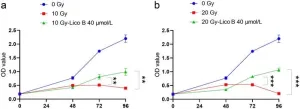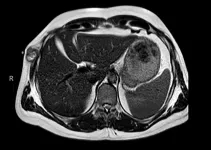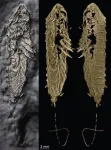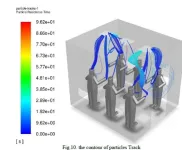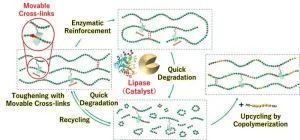(Press-News.org) WASHINGTON, DC – OCTOBER 28, 2024 – The EVOLVED trial found that early aortic valve intervention in patients with asymptomatic severe aortic stenosis (AS) and mid-wall myocardial fibrosis on magnetic resonance imaging did not reduce the incidence of the composite primary endpoint of all-cause death or unplanned aortic stenosis hospitalization compared with guideline-directed conservative management.
Findings were reported today at TCT 2024, the annual scientific symposium of the Cardiovascular Research Foundation (CRF). TCT is the world’s premier educational meeting specializing in interventional cardiovascular medicine. The results were also published simultaneously in the Journal of the American Medical Association.
Aortic valve replacement via surgical or transcatheter approaches is the primary treatment for severe AS but it is reserved for those with symptomatic disease or those with asymptomatic disease and a left ventricular ejection fraction less than 50 percent. Myocardial fibrosis is a key driver of left ventricular decompensation in AS and is a powerful predictor of patient mortality. Late gadolinium enhancement on cardiac magnetic resonance imaging can directly visualize myocardial fibrosis, providing an objective marker that the left ventricle is starting to decompensate. Whether early intervention for asymptomatic severe AS in patients with myocardial fibrosis can improve outcomes is unknown.
The EVOLVED trial was an international multicenter prospective randomized open-label blinded-endpoint trial, conducted at 24 sites in the United Kingdom and Australia. Participants were asymptomatic with severe AS (aortic valve peak velocity ≥ 4.0 m/s, ≥ 3.5 m/s with an indexed aortic valve area <0.6 cm2/m2). Key exclusion criteria included left ventricular ejection fraction less than 50%, concomitant severe aortic or mitral regurgitation, eGFR greater than 30 mL/min/1.73 m2, contraindications to magnetic resonance, or patients deemed unfit for intervention.
A total of 427 participants were screened. Of these subjects, 278 were eligible for cardiac magnetic resonance and the 224 participants with myocardial fibrosis were randomized to early intervention (n=113) or guideline-directed conservative management (n=111). The 49 participants without myocardial fibrosis were entered into an observational registry to maintain blinding. In addition, the choice of surgical or transcatheter valve replacement was determined by the local heart valve team.
The median time-to-intervention was 15 months shorter among patients randomized to valvular intervention. The primary end point, consisting of the composite of all-cause death or unplanned aortic stenosis-related hospitalization, was not met [Hazard Ratio 0.79 (95% CI 0.44 to 1.43, p=0.44)]. The secondary endpoint of all-cause death was also not met [Hazard Ratio 1.22 (95% CI 0.59 to 2.51)]. However, unplanned aortic stenosis-related hospitalization was less in the early intervention group [Hazard Ratio 0.37 (95% CI 0.16 to 0.88)]. In addition, NYHA Symptom Class at 12 months favored the early intervention group [Odds Ratio 0.37 (95% CI 0.20 to 0.70).
“Although early intervention did not reduce the incidence of the composite primary endpoint of all-cause death or unplanned aortic stenosis hospitalization, our study did find other benefits,” said Mark R. Dweck, MD, PhD, Chair of Clinical Cardiology at the University of Edinburgh, British Heart Foundation Senior Clinical Research Fellow and a Consultant Cardiologist at the University of Edinburgh. “The principal benefit of early intervention appears to be in the reduction of emergency hospitalization and in preventing the development of limiting symptoms. This appears to be a consistent finding across all the trials to date and an important outcome for patients with this condition.”
The study was funded by Sir Jules Thorn Charitable Trust.
Dr. Dweck reported the following disclosures: consulting fees/honoraria from Novartis, AstraZeneca, Pfizer, Bristol Myers Squibb, Amarin, Jupiter Bioventures, Beren and Silence Therapeutics.
About CRF® and TCT®
The Cardiovascular Research Foundation® (CRF®) is a global leader in interventional cardiovascular medicine, driving innovation, spearheading groundbreaking research, and transforming education in the field. Through its relentless pursuit of excellence, CRF® not only accelerates medical breakthroughs but also equips healthcare professionals with the tools and knowledge necessary to enhance survival rates and elevate the quality of life for millions worldwide. CRF’s centers of excellence include the CRF Skirball Center for Innovation, CRF Clinical Trials Center, CRF Center for Education, CRF Digital, TCTMD, and Structural Heart: The Journal of the Heart Team.
Transcatheter Cardiovascular Therapeutics® (TCT®) is the annual scientific symposium of CRF® and the world’s premier educational meeting specializing in interventional cardiovascular medicine. Anchored in a legacy spanning over three decades, TCT® is a world-class educational experience featuring disruptive innovation, scientific breakthroughs, expert-led tutorials, hands-on training, and ample opportunities for networking and collaboration.
For more information, visit www.crf.org and www.tctconference.com.
###
END
Earlier this year, researchers at the Flatiron Institute’s Center for Computational Quantum Physics (CCQ) announced that they had successfully used a classical computer and sophisticated mathematical models to thoroughly outperform a quantum computer at a task that some thought only quantum computers could solve.
Now, those researchers have determined why they were able to trounce the quantum computer at its own game. Their answer, presented on October 29 in Physical Review Letters, reveals that the quantum problem they tackled — involving ...
University of Texas at Dallas mechanical engineers have designed a 3D-printed femur that could help doctors prepare for surgeries to repair bones and develop treatments for bone tumors.
The engineers, who worked in collaboration with UT Southwestern Medical Center orthopedic surgeons, published their first study on the 3D-printed thigh bone online Aug. 5 in the Journal of Orthopaedic Research.
The study, which focused on the middle section of the bone, establishes 3D-printing parameters for a femur for use in biomechanical testing. Researchers said more studies will be needed before the technology could be available for widespread use.
To study and validate innovative surgical implants ...
A study led by researchers at the University of Colorado Anschutz Medical Campus reveals patients and providers have more positive overall care experiences when the entire healthcare team is a part of bedside interdisciplinary rounds (BIDR).
The study published today in the Journal of General Internal Medicine.
The study found that BIDR, when the team meets at a patients’ bedside in the hospital to discuss care plans, helps build trust between patients and their healthcare providers and within healthcare teams by allowing everyone to observe and work together more closely.
“Traditional ...
Background and objectives
Radiation injury poses a serious threat to human health, causing complex and multifaceted damage to cells and tissues. Such injury can be caused by various factors, including nuclear accidents, medical radiation therapy, and space travel. Currently, finding effective treatment methods and drugs to mitigate the harmful effects of radiation injury on the human body is a crucial research direction. This study aimed to explore the protective effects and mechanisms of Licochalcone ...
“This case report highlights the importance of full tumor genotyping to identify potentially actionable targets in rare tumors such as malignant glomus tumors.”
BUFFALO, NY- October 29, 2024 – A new case report was published in Oncotarget's Volume 15 on October 11, 2024, entitled “Complete response to encorafenib plus binimetinib in a BRAF V600E-mutant metastasic malignant glomus tumor.”
As highlighted in the abstract, glomus tumors (GT) are rare mesenchymal neoplasms originating in dermal arteriovenous structures involved in thermoregulation. ...
UNDER EMBARGO UNTIL 15:00 GMT / 11:00 ET TUESDAY 29 OCTOBER 2024
Gold bugs: spectacular new fossil arthropod preserved in fool’s gold
Images available via link in the notes section
A new 450-million-year-old fossil arthropod, preserved in 3D by iron pyrite (fool’s gold), has been unveiled by scientists.
The new species, Lomankus edgecombei, is distantly related to spiders, scorpions, and horseshoe crabs.
The findings have been published today (29 Oct) in the journal Current Biology.
A team of researchers led by Associate Professor Luke Parry, Department of Earth Sciences, University of Oxford, have unveiled a spectacular ...
WASHINGTON, Oct. 29, 2024 – While many smoking rooms in U.S. airports have closed in recent years, they are still common in other airports around the world. These lounges can be ventilated, but how much does it actually help the dispersion of smoke?
Research published in Physics of Fluids, by AIP Publishing, shows that not all standing positions in airport smoking lounges are created equal.
Researchers from the University of Hormozgan in Iran studied nicotine particles in a simulated airport smoking room and found that the thermal environment and positioning of smokers influenced how particles ...
AURORA, Colo. (Oct. 29, 2024) – An ancient gene mutation among First Nations inhabitants of Oceania may make them more susceptible to infectious diseases like influenza, according to a new study by scientists at the University of Colorado Anschutz Medical Campus.
“We found quite a diverse set of genes in this population but there was one allele that really stood out in terms of genetic composition,” said the study’s lead author Paul Norman, PhD, professor of biomedical informatics at the University of Colorado School of Medicine. “We did some investigating, and we suspect this allele ...
New Haven, Conn. — Paleontologists have identified fossils of an ancient species of bug that spent the past 450 million years covered in fool’s gold in central New York.
The new species, Lomankus edgecombei, is a distant relative of modern-day horseshoe crabs, scorpions, and spiders. It had no eyes, and its small front appendages were best suited for rooting around in dark ocean sediment, back when what is now New York state was covered by water.
Lomankus also happens to be bright gold — thanks to layers of pyrite ...
Osaka, Japan—Achieving a sustainable society requires the development of advanced degradable plastics, or polymers, which are molecules composed of long chains of repeating units. The goal of a resource-circulating society is now one step closer thanks to the efforts of a team from Osaka University that has developed tough biodegradable plastics by including movable crosslinking groups.
In a study published this month in Chem, the researchers have revealed that developing polymers with movable crosslinks not only increases their strength but also promotes degradation by enzymes under mild conditions.
Plastics and polymers need to achieve both desirable performance ...


